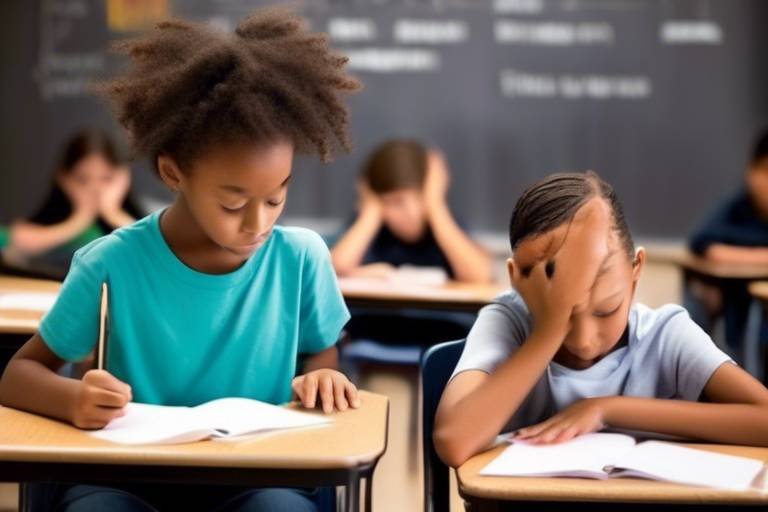Strategies for Building Resilience in Students
In today's fast-paced world, students face a multitude of challenges that can often feel overwhelming. From academic pressures to social dynamics, the ability to bounce back from setbacks is more crucial than ever. Resilience is not just a trait; it’s a skill that can be cultivated and strengthened over time. This article explores effective strategies to help students develop resilience, enabling them to navigate challenges, adapt to adversity, and thrive academically and personally.
Resilience is the capacity to recover quickly from difficulties. Imagine a rubber band: it stretches and bends but returns to its original shape. Similarly, resilient students can adapt to changes and recover from disappointments. The importance of resilience in a student's life cannot be overstated; it impacts not only their academic performance but also their emotional well-being. When students possess resilience, they are better equipped to handle stress, maintain motivation, and foster a positive outlook on life.
One of the most effective ways to bolster resilience is by encouraging a growth mindset. This concept, popularized by psychologist Carol Dweck, revolves around the belief that abilities and intelligence can be developed through dedication and hard work. In educational settings, teachers can promote a growth mindset by implementing various techniques:
- Encouraging students to embrace challenges as opportunities for growth.
- Celebrating effort over results.
- Providing constructive feedback that focuses on improvement.
Positive self-talk is a powerful tool that can significantly influence students' resilience. When students learn to replace negative thoughts with constructive affirmations, they build a more positive self-image. For instance, instead of thinking, "I can’t do this," they can reframe it to, "I can learn how to do this with practice." Teachers can introduce methods such as journaling or guided discussions to help students recognize and change their internal dialogue.
Self-reflection is crucial for personal growth. By assessing their experiences and learning from them, students can develop a deeper understanding of their strengths and weaknesses. Techniques like keeping a reflection journal or engaging in peer discussions can facilitate this process. Encouraging students to ask themselves questions like, "What did I learn from this experience?" or "How can I approach this differently next time?" can foster a culture of continuous improvement.
Setting achievable goals enhances motivation and resilience. When students have clear, realistic objectives, they are more likely to stay focused and committed. Teachers can guide students in setting both personal and academic goals by using the SMART criteria—Specific, Measurable, Achievable, Relevant, and Time-bound. This structured approach helps students visualize their success and maintain a sense of direction.
Supportive relationships are vital for resilience. The role of teachers, peers, and family cannot be understated. A strong support system provides students with the emotional backing they need to face challenges. Teachers can foster a supportive environment by being approachable and actively listening to their students. Additionally, promoting teamwork and collaboration among peers can help build lasting friendships that provide comfort during tough times.
Teaching coping strategies equips students with tools to manage stress and adversity effectively. Schools can implement various techniques and practices that help students develop these essential skills. For example, mindfulness practices have been shown to be particularly effective in reducing anxiety and enhancing focus.
Mindfulness practices can help students manage stress effectively. Simple exercises such as deep breathing, meditation, or even mindful walking can be incorporated into daily routines. These practices not only promote relaxation but also enhance students' ability to concentrate and remain present, which is crucial for academic success.
Problem-solving skills are essential for resilience. When students learn how to approach challenges methodically and creatively, they become more self-sufficient. Teachers can encourage this by presenting real-world problems and guiding students through the process of brainstorming solutions, evaluating options, and implementing their ideas. This hands-on approach fosters critical thinking and empowers students to tackle obstacles with confidence.
- What is resilience? Resilience is the ability to recover from setbacks and adapt to challenges effectively.
- How can parents help build resilience in their children? Parents can promote resilience by encouraging a growth mindset, fostering open communication, and supporting their children through challenges.
- Why is a growth mindset important? A growth mindset helps students view challenges as opportunities for growth, which enhances their resilience and overall learning experience.

Understanding Resilience
Resilience is more than just a buzzword; it's a vital skill that empowers students to navigate the ups and downs of life. Imagine resilience as a sturdy rubber band—it can stretch and bend but ultimately returns to its original shape. This ability to bounce back from setbacks is crucial, especially in a world where challenges are as common as homework assignments. When students cultivate resilience, they not only enhance their academic performance but also improve their emotional well-being. It's like having a secret weapon in their back pocket, ready to tackle any obstacle that comes their way.
Why is resilience so important in students' lives? Well, think about it: school can be a rollercoaster ride filled with tests, social dynamics, and personal expectations. Students often face pressure to excel, which can lead to feelings of anxiety and self-doubt. Resilience acts as a buffer against these stressors, enabling students to maintain their focus and motivation. It helps them understand that failure is not the end; rather, it's an opportunity to learn and grow. In fact, research shows that resilient students are more likely to have better grades, higher attendance rates, and stronger relationships with peers and teachers.
Moreover, resilience impacts emotional health significantly. Students who develop this skill are better equipped to handle life's inevitable challenges—whether it's a poor grade, a friendship fallout, or family issues. They learn to regulate their emotions, cope with stress, and approach problems with a positive mindset. This emotional intelligence not only helps them in school but also prepares them for future challenges in life. The ability to adapt and thrive in the face of adversity is a lesson that extends far beyond the classroom.
To further illustrate the importance of resilience, consider the following benefits:
- Enhanced Academic Performance: Resilient students tend to achieve better grades and are more engaged in their learning.
- Improved Emotional Regulation: They are more capable of managing their emotions and stress levels.
- Stronger Relationships: Resilient individuals often build and maintain healthier relationships with peers and adults.
- Greater Life Satisfaction: They experience higher levels of happiness and fulfillment in their lives.
In summary, understanding resilience is essential for fostering a supportive educational environment. By equipping students with the tools to develop this skill, educators and parents can help them navigate the complexities of life with confidence and strength. Resilience is not just about surviving; it's about thriving, and every student deserves the chance to harness this power.

Promoting a Growth Mindset
In today's fast-paced educational landscape, cultivating a growth mindset among students is more crucial than ever. But what exactly does this mean? A growth mindset is the belief that abilities and intelligence can be developed through dedication and hard work. This perspective fosters a love for learning and resilience, ultimately leading to greater achievement. Imagine a world where students embrace challenges rather than shy away from them; that's the power of a growth mindset!
Encouraging students to view challenges as opportunities rather than obstacles is the first step in promoting this mindset. When faced with a tough math problem or a challenging project, students should be taught to ask themselves, "What can I learn from this?" Instead of feeling defeated, they can see these moments as stepping stones toward personal growth. This shift in perspective can be transformative, allowing students to tackle difficulties head-on and develop the skills necessary to overcome future challenges.
To facilitate the development of a growth mindset, educators can implement several effective techniques in the classroom. Here are a few strategies:
- Modeling Growth Mindset Language: Teachers should use language that promotes a growth mindset. Phrases like "You haven't mastered this yet" instead of "You can't do this" can help students understand that effort leads to improvement.
- Celebrating Effort and Progress: Instead of solely focusing on grades, educators should celebrate the effort and progress made by students. Acknowledging hard work reinforces the idea that persistence pays off.
- Encouraging Risk-Taking: Creating a safe space for students to take risks and make mistakes is essential. When students feel safe to fail, they are more likely to push their boundaries and explore new ideas.
Another vital aspect of promoting a growth mindset is encouraging positive self-talk. Students often engage in negative self-talk, which can hinder their performance and confidence. Teaching them how to replace these negative thoughts with constructive affirmations can significantly enhance their resilience. For instance, instead of thinking, "I will never get this right," they can remind themselves, "I can improve with practice." This simple shift can make a world of difference in how they approach challenges.
Moreover, self-reflection plays a pivotal role in developing a growth mindset. Students should be encouraged to reflect on their experiences, both successes and failures. By assessing what worked, what didn't, and why, they can gain valuable insights that inform their future efforts. Techniques such as journaling or group discussions can facilitate this reflective process, allowing students to share their thoughts and learn from one another.
Setting realistic goals is another key strategy. When students set achievable goals, they not only increase their motivation but also create a roadmap for success. Goals should be specific, measurable, and time-bound, allowing students to track their progress and celebrate small victories along the way. This approach not only builds resilience but also instills a sense of accomplishment, reinforcing their belief in their ability to grow and improve.
In conclusion, promoting a growth mindset in students is about fostering an environment where challenges are embraced, effort is celebrated, and learning is a continuous journey. By providing the right tools and support, educators can empower students to develop resilience and thrive academically and personally. The journey may be challenging, but with a growth mindset, students can transform obstacles into opportunities for growth.
Q1: What is a growth mindset?
A1: A growth mindset is the belief that abilities and intelligence can be developed through dedication and hard work. It fosters resilience and a love for learning.
Q2: How can teachers promote a growth mindset in the classroom?
A2: Teachers can promote a growth mindset by using growth-oriented language, celebrating effort and progress, encouraging risk-taking, and teaching positive self-talk.
Q3: Why is self-reflection important for students?
A3: Self-reflection helps students assess their experiences, learn from successes and failures, and gain insights that inform their future efforts.
Q4: What role do realistic goals play in developing resilience?
A4: Setting realistic goals enhances motivation and provides a clear roadmap for success, helping students track their progress and celebrate achievements.

Encouraging Positive Self-Talk
Positive self-talk is like a secret superpower that every student can harness to help them navigate the ups and downs of academic life. Imagine facing a challenging math problem or preparing for a big presentation; how a student talks to themselves during these moments can make all the difference. Instead of spiraling into negativity with thoughts like "I can’t do this" or "I always mess up," students can learn to flip the script. By replacing those harmful thoughts with constructive affirmations, they can cultivate a mindset that embraces challenges rather than shying away from them.
To encourage positive self-talk, educators and parents can implement a few simple yet effective strategies. One powerful technique is to model positive self-talk in everyday situations. For instance, when a student faces a setback, instead of focusing on the failure, adults can say things like, "This is a tough situation, but I believe you can learn from it." This not only demonstrates resilience but also encourages students to adopt a similar approach in their own lives.
Another effective method is to create a Positive Affirmation Board in classrooms or at home. This board can be filled with uplifting quotes and affirmations that students can refer to whenever they're feeling down. Here’s a quick example of what such a board might include:
| Affirmation | Meaning |
|---|---|
| "I am capable of achieving my goals." | This reinforces the belief in one’s abilities. |
| "Mistakes help me learn." | This encourages a growth mindset and reduces fear of failure. |
| "I can handle challenges." | This builds confidence in overcoming obstacles. |
Moreover, teaching students to recognize and challenge their negative thoughts can significantly enhance their resilience. Encourage them to ask questions like, "Is this thought really true?" or "What evidence do I have to support this belief?" This process of self-reflection can help students understand that their thoughts are not always facts, which can be incredibly liberating.
Incorporating journaling into their routine can also be a fantastic way for students to practice positive self-talk. By writing down their thoughts and feelings, they can identify patterns in their thinking that may be holding them back. Students can then consciously rewrite those negative thoughts into positive statements. For example, if a student writes, "I am terrible at public speaking," they can transform it into, "I am improving my public speaking skills every day." This simple act of rewriting can empower students and help them shift their mindset.
Ultimately, encouraging positive self-talk is about creating an environment where students feel safe to express themselves and where they can learn to embrace their imperfections. By fostering this habit, we equip them with the tools they need to not only tackle academic challenges but also to thrive in life beyond the classroom.

Techniques for Self-Reflection
Self-reflection is like holding up a mirror to our experiences, allowing us to see not just our actions but also our thoughts and feelings. It’s a powerful tool that can help students grow, learn, and adapt. But how can students effectively engage in self-reflection? Here are some techniques that can guide them in this vital process.
One effective method is to encourage students to maintain a reflection journal. This journal serves as a personal space where they can write down their thoughts after a class, project, or even a tough day. By articulating their feelings, students can identify patterns in their responses to challenges. For instance, they might notice that they often feel overwhelmed during exams. Recognizing this can help them develop strategies to cope, such as time management techniques or relaxation exercises.
Another technique is to use guided reflection questions. These questions can prompt deeper thinking and help students analyze their experiences. Here are a few examples of questions they might consider:
- What was the most challenging part of my day, and how did I respond?
- What did I learn from a recent failure?
- How did I contribute to a positive outcome in a group project?
Additionally, peer reflections can be immensely beneficial. Students can pair up and share their experiences, providing feedback and insights to one another. This not only fosters a sense of community but also helps them see different perspectives, which can lead to greater understanding and empathy.
Lastly, incorporating mindfulness practices into self-reflection can enhance the process. For example, students can take a few minutes to meditate or practice deep breathing before reflecting. This helps clear their minds and allows them to approach their thoughts with a fresh perspective. By creating a calm mental space, students can reflect more effectively and gain valuable insights into their behaviors and emotions.
In summary, self-reflection is an essential skill for students, empowering them to learn from their experiences and grow. By using techniques such as maintaining a reflection journal, answering guided questions, engaging in peer reflections, and practicing mindfulness, students can cultivate a habit of self-reflection that will serve them well throughout their lives.
Q: How often should students engage in self-reflection?
A: Ideally, students should reflect on their experiences regularly—daily or weekly. Consistency helps reinforce the habit and makes it more effective over time.
Q: Can self-reflection improve academic performance?
A: Yes! By reflecting on their learning processes and challenges, students can identify areas for improvement and develop strategies to enhance their academic performance.
Q: What if a student struggles with self-reflection?
A: It's normal to find self-reflection challenging at first. Encouraging students to start small, perhaps by reflecting on just one event or feeling, can make the process more manageable.
Q: Are there any tools to assist with self-reflection?
A: Yes! There are many apps and online platforms designed for journaling and self-reflection that can provide prompts and help students track their thoughts over time.

Setting Realistic Goals
Setting realistic goals is like charting a course on a map; it gives students a clear direction and purpose. When students have achievable goals, they are more likely to stay motivated and engaged in their learning journey. Think about it: when you aim for something that feels out of reach, it can be discouraging. However, when those goals are attainable, it’s like reaching small milestones on a longer journey, which can be incredibly rewarding and empowering.
To help students set realistic goals, it’s essential to guide them through a structured process. First, encourage them to identify their passions and strengths. This can be done through self-reflection exercises where they consider what subjects excite them or what activities they excel at. Once they have a clear understanding of their interests, they can set goals that align with these passions, making the pursuit more enjoyable and meaningful.
Next, it’s crucial to teach students the importance of SMART goals. This acronym stands for Specific, Measurable, Achievable, Relevant, and Time-bound. Here’s how each element plays a role:
| SMART Element | Description |
|---|---|
| Specific | Goals should be clear and specific, answering the questions of who, what, where, when, and why. |
| Measurable | Students should be able to track their progress and measure the outcomes. |
| Achievable | Goals should be realistic and attainable, considering the student’s current abilities and resources. |
| Relevant | Goals should matter to the student and align with their broader life objectives. |
| Time-bound | Setting a deadline creates a sense of urgency and helps maintain focus. |
By using the SMART framework, students can break down their larger aspirations into manageable steps. For example, rather than saying, "I want to improve my math skills," a SMART goal would be, "I will complete 10 math practice problems every week for the next month." This not only sets a clear expectation but also allows students to see their progress over time.
Moreover, it’s important to encourage students to regularly review and adjust their goals. Life is fluid, and sometimes goals need to be adapted based on new information or changing circumstances. By fostering a mindset that embraces flexibility, students can learn that it’s okay to pivot and re-evaluate their paths as they grow and evolve.
Lastly, celebrating achievements, no matter how small, is vital in reinforcing the importance of goal-setting. When students reach a goal, they should take a moment to acknowledge their hard work and reflect on what they learned during the process. This not only boosts their confidence but also motivates them to set new goals and continue their journey toward resilience.
- Why is setting realistic goals important for students?
Realistic goals help students stay motivated, focused, and engaged, making their learning experience more enjoyable and productive. - How can students identify their passions?
Students can explore their interests through self-reflection, trying new activities, and seeking feedback from teachers and peers. - What are SMART goals?
SMART goals are Specific, Measurable, Achievable, Relevant, and Time-bound objectives that provide a clear framework for goal-setting. - How often should students review their goals?
Students should review their goals regularly, ideally every few weeks, to assess their progress and make necessary adjustments.

Building Strong Relationships
When it comes to resilience, one of the most powerful tools in a student's toolkit is the ability to build strong relationships. Think of it as the sturdy roots of a tree; without them, the tree may sway and eventually fall in the face of adversity. Strong connections with peers, teachers, and family members provide emotional support, guidance, and a sense of belonging, all of which are essential for navigating life's challenges. So, how can we foster these vital relationships?
First and foremost, it’s important to create an environment where open communication is encouraged. Students should feel safe expressing their thoughts and feelings without fear of judgment. This can be achieved through regular check-ins, whether in the classroom or at home. For instance, teachers can set aside time for students to share their thoughts during class discussions or one-on-one meetings. This not only helps students articulate their feelings but also strengthens the bond between them and their educators.
Moreover, peer relationships play a significant role in a student's resilience. Friends can offer support during tough times, and having a solid support system can make a world of difference. Schools can facilitate this by promoting group activities, team projects, and collaborative learning experiences. These interactions not only help students develop social skills but also foster a sense of community. When students work together, they learn to rely on one another, which builds trust and camaraderie.
Family involvement is equally crucial. Parents and guardians should actively participate in their children's education, attending school events or volunteering for activities. This involvement signals to students that their education is valued, which can enhance their motivation and resilience. Additionally, families can create a supportive home environment by encouraging open dialogue about school experiences, challenges, and successes. When students know that their families are invested in their well-being, they feel more empowered to face obstacles head-on.
To further illustrate the importance of strong relationships, consider the following table that highlights key benefits:
| Type of Relationship | Benefits |
|---|---|
| Peer Relationships |
|
| Teacher Relationships |
|
| Family Relationships |
|
In conclusion, building strong relationships is not just a nice-to-have; it’s a necessity for fostering resilience in students. By creating an environment that encourages open communication, promoting peer collaboration, and involving families in the educational process, we can equip students with the emotional tools they need to thrive. After all, just like a well-rooted tree can weather any storm, so too can resilient students flourish when supported by strong relationships.
Q: How do strong relationships contribute to resilience?
A: Strong relationships provide emotional support, guidance, and a sense of belonging, all of which are crucial for students facing challenges.
Q: What role do teachers play in building relationships?
A: Teachers can foster strong relationships by encouraging open communication, providing mentorship, and creating a safe space for students to express themselves.
Q: How can parents get involved in their child's education?
A: Parents can participate by attending school events, volunteering, and maintaining open dialogue about their child's experiences and challenges.

Developing Coping Strategies
In today’s fast-paced world, where challenges can arise unexpectedly, it’s crucial for students to develop effective coping strategies. These strategies are not just tools; they are lifelines that help students navigate through stress and adversity. Imagine coping strategies as a backpack filled with essential gear for a hiking trip. Just as a hiker prepares for various terrains, students need to equip themselves with skills that will help them tackle the ups and downs of academic and personal life.
One of the most effective ways to help students is by teaching them mindfulness practices. Mindfulness is about being present in the moment and can significantly reduce anxiety. Simple exercises, such as deep breathing or guided imagery, can be introduced in the classroom. For instance, a quick five-minute breathing exercise at the start of a class can help students center themselves, ready to absorb information. Studies have shown that even a few minutes of mindfulness can enhance focus and improve emotional regulation.
Furthermore, encouraging students to identify their stressors is vital. When students recognize what triggers their stress, they can develop personalized coping mechanisms. This might involve creating a stress diary where they jot down their feelings and the situations that lead to them. Over time, they can spot patterns and work on addressing these stressors head-on. This self-awareness is akin to having a map on a hiking journey, guiding them through tricky paths.
Another key aspect is fostering problem-solving skills. Life will always throw curveballs, but teaching students how to approach these challenges can empower them. For instance, when faced with a difficult assignment, instead of feeling overwhelmed, students can break the task into smaller, manageable parts. This method not only makes the challenge seem less daunting but also builds their confidence as they complete each segment. It’s like climbing a mountain—taking one step at a time rather than trying to leap to the summit in one go.
Incorporating group activities can also enhance coping strategies. When students work together, they learn to support one another, share experiences, and brainstorm solutions. This collaborative approach fosters a sense of community and belonging, which is essential for emotional well-being. Just as a team of climbers relies on each other for safety and motivation, students can lean on their peers for encouragement and guidance.
Finally, it’s essential to teach students about the importance of seeking help when needed. Encouraging them to talk to a trusted teacher, counselor, or family member can make a world of difference. Just like a hiker might need assistance navigating a tough trail, students should know that reaching out for support is a sign of strength, not weakness.
- What are coping strategies?
Coping strategies are techniques that individuals use to manage stress and adversity. They help in navigating challenges effectively. - Why is mindfulness important for students?
Mindfulness helps students stay present and reduces anxiety, leading to better focus and emotional regulation. - How can teachers help students develop problem-solving skills?
Teachers can encourage students to break tasks into smaller parts and engage in group discussions to brainstorm solutions. - Is it okay for students to seek help?
Absolutely! Seeking help is a healthy coping mechanism and shows strength and self-awareness.

Mindfulness and Stress Management
In today’s fast-paced world, students often find themselves overwhelmed with academic pressures, social dynamics, and personal challenges. This is where mindfulness comes into play as a powerful tool for stress management. Mindfulness is the practice of being present in the moment, fully engaging with one's thoughts and feelings without judgment. Imagine trying to juggle multiple balls in the air; mindfulness is like focusing on one ball at a time, allowing you to manage each one effectively without dropping any.
Implementing mindfulness in the classroom can significantly enhance students' ability to cope with stress. Studies have shown that students who practice mindfulness regularly report lower levels of anxiety and improved concentration. But how can educators and parents encourage this practice? Here are some effective techniques:
- Mindful Breathing: Teach students to focus on their breath. A simple exercise involves inhaling deeply through the nose, holding for a few seconds, and exhaling slowly through the mouth. This can be done for just a few minutes each day.
- Body Scan: Guide students through a body scan meditation where they focus on different parts of their body, noticing any tension and consciously relaxing those areas.
- Gratitude Journaling: Encourage students to keep a journal where they write down things they are grateful for each day. This practice helps shift focus from stressors to positive aspects of their lives.
In addition to these techniques, it’s essential to create a mindfulness-friendly environment in schools. This could include designated quiet spaces where students can retreat for a few moments of reflection or mindfulness practice. Teachers can also incorporate mindfulness breaks into their lessons, allowing students to reset and refocus before moving on to new material.
Moreover, the benefits of mindfulness extend beyond the classroom. When students practice mindfulness regularly, they develop a greater awareness of their emotions and reactions. This heightened awareness can lead to better emotional regulation, allowing them to respond to stressors more effectively rather than reacting impulsively. Think of it as sharpening a knife; the more you practice, the more precise and effective you become at cutting through the chaos of daily life.
In conclusion, incorporating mindfulness into students' daily routines can be a game changer in their approach to stress management. Not only does it equip them with essential coping strategies, but it also fosters a sense of inner peace and resilience that will serve them throughout their lives. As we continue to explore effective methods for enhancing student resilience, mindfulness stands out as a fundamental practice that can transform the educational experience.
Q1: What is mindfulness?
Mindfulness is the practice of being fully present in the moment, engaging with thoughts and feelings without judgment. It helps individuals manage stress and improve focus.
Q2: How can mindfulness help students?
Mindfulness can reduce anxiety, improve concentration, and enhance emotional regulation, allowing students to cope better with academic and personal challenges.
Q3: What are some simple mindfulness exercises for students?
Some effective exercises include mindful breathing, body scans, and gratitude journaling. These practices can easily be integrated into daily routines.
Q4: Can mindfulness be taught in schools?
Yes, educators can incorporate mindfulness practices into their lessons and create supportive environments that promote mindfulness among students.

Encouraging Problem-Solving Skills
Problem-solving is like a muscle; the more you exercise it, the stronger it becomes. For students, developing effective problem-solving skills is essential not just for academic success, but for life in general. Imagine being faced with a complex math problem or a challenging group project. Without a solid strategy to tackle these issues, students can feel overwhelmed and frustrated. By equipping them with the right tools and techniques, we can help them navigate challenges with confidence and creativity.
One effective way to encourage problem-solving skills is through a structured approach that breaks down the problem into manageable parts. This method can be likened to a puzzle; instead of trying to fit all the pieces together at once, students can focus on one section at a time. Here’s a simple framework that can be taught in classrooms:
| Step | Description |
|---|---|
| 1. Identify the Problem | Encourage students to clearly define what the problem is. Ask them questions like, "What exactly is the issue?" or "What do we need to solve?" |
| 2. Brainstorm Possible Solutions | Have students think of as many solutions as possible, no matter how outlandish. This encourages creativity and open-mindedness. |
| 3. Evaluate Solutions | Teach students to weigh the pros and cons of each solution. Which one is the most feasible? What are the potential outcomes? |
| 4. Implement the Solution | Once a solution is chosen, have students create a plan to implement it. What steps will they take? |
| 5. Reflect on the Outcome | After implementing the solution, encourage students to reflect on the process. What worked? What didn’t? What could they do differently next time? |
This structured approach not only helps students tackle specific problems but also instills a sense of ownership over their learning process. By actively engaging in problem-solving, students learn to trust their judgment and develop resilience in the face of challenges.
Moreover, incorporating real-world scenarios into lessons can make problem-solving more relatable and engaging. For instance, teachers can present students with case studies related to their interests, such as environmental issues or social challenges. This not only makes the learning process fun but also helps students understand the relevance of their problem-solving skills in everyday life.
Another powerful technique is to foster a collaborative environment. When students work together to solve problems, they can share diverse perspectives and strategies. This not only enhances their problem-solving skills but also builds teamwork and communication abilities, which are crucial in both academic and professional settings. Encourage group discussions and peer feedback, allowing students to learn from one another and refine their approaches.
Lastly, it's essential to celebrate successes, no matter how small. Acknowledging students' efforts and achievements in problem-solving can boost their confidence and motivate them to tackle even more challenging issues in the future. Remember, resilience is built through experience, and each problem solved is a step towards a more resilient mindset.
- What are some common problems students face that require problem-solving skills?
Students often encounter challenges in subjects like math, science, and group projects, as well as personal issues such as time management and peer relationships. - How can parents support their children in developing problem-solving skills?
Parents can encourage their children to think critically by discussing everyday problems and brainstorming solutions together. - Are there specific activities that can help improve problem-solving skills?
Yes! Activities like puzzles, games, and team challenges can be effective in enhancing problem-solving abilities.
Frequently Asked Questions
- What is resilience and why is it important for students?
Resilience is the ability to bounce back from setbacks and challenges. For students, developing resilience is crucial as it helps them navigate academic pressures and personal difficulties. Resilient students are more likely to adapt to change, maintain a positive outlook, and persist in the face of adversity, leading to better emotional well-being and academic success.
- How can a growth mindset be promoted in educational settings?
Promoting a growth mindset involves encouraging students to view challenges as opportunities for growth rather than obstacles. Teachers can implement strategies such as praising effort over outcome, sharing stories of perseverance, and providing constructive feedback. This approach fosters an environment where students feel safe to take risks and learn from their mistakes.
- What techniques can help students practice positive self-talk?
Teaching students to practice positive self-talk can significantly enhance their resilience. Techniques include encouraging them to identify negative thoughts and replace them with positive affirmations, using journals to reflect on their successes, and role-playing scenarios where they can practice constructive dialogue with themselves. These methods help students build a more supportive inner voice.
- How can self-reflection contribute to personal growth in students?
Self-reflection allows students to assess their experiences, understand their emotions, and learn from their actions. Techniques such as guided journaling, group discussions, and reflective essays can facilitate this process. By regularly engaging in self-reflection, students can identify areas for improvement and celebrate their progress, ultimately fostering a growth mindset.
- What role do supportive relationships play in building resilience?
Supportive relationships with teachers, peers, and family members are vital for fostering resilience in students. These connections provide emotional support, encouragement, and a sense of belonging, which can help students cope with stress and challenges. Creating a positive school culture where students feel valued and supported can significantly enhance their resilience.
- What coping strategies can be taught to help students manage stress?
Teaching students effective coping strategies is essential for helping them manage stress. Techniques such as mindfulness practices, deep breathing exercises, and time management skills can empower students to handle pressure more effectively. Schools can incorporate these practices into daily routines, making it easier for students to develop healthy coping mechanisms.
- How can mindfulness practices benefit students in managing stress?
Mindfulness practices, such as meditation and focused breathing, can significantly benefit students by helping them stay present and reduce anxiety. These techniques encourage relaxation and enhance emotional regulation, allowing students to approach challenges with a clearer mind. Incorporating mindfulness into the classroom can create a calmer learning environment for all students.
- What strategies can help students develop problem-solving skills?
Encouraging students to develop problem-solving skills is crucial for building resilience. Strategies include teaching them to break problems into smaller, manageable parts, brainstorming multiple solutions, and evaluating the outcomes of their choices. By approaching challenges methodically and creatively, students can build confidence in their ability to overcome obstacles.



















